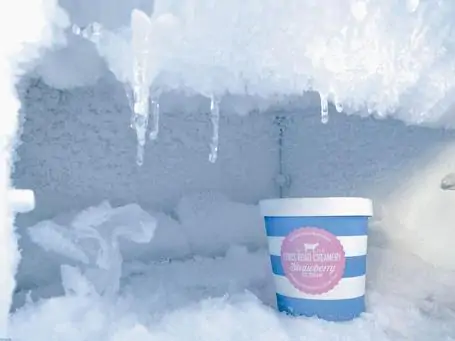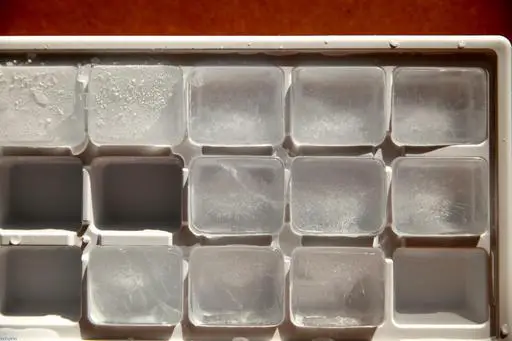Are you wondering about the different KitchenAid ice maker blinking red light codes and their meanings? If so, then you’ve come to the right place. In this article, we’ll be discussing some of the most common blinking red light codes for Kitchenaid ice makers and what they mean.
What Are Kitchenaid Ice Maker Blinking Red Light Codes?
As we mentioned before, Kitchenaid ice maker blinking red light codes are simply different combinations of flashes that indicate a specific problem. By understanding what each code means, you can quickly troubleshoot and fix the issue at hand.
Most Common Blinking Red Light Codes
Flash
This indicates that the ice maker is not receiving enough water. Make sure that the water line is properly connected and that there is no kink or blockage in the line.
Slow Blink
This means that the ice maker’s cycle is complete, and it will begin making ice again soon.
Fast Blink
A fast blink indicates that the ice maker’s thermostat has tripped. This could be due to a power surge or other problems. Reset the ice maker by unplugging it for 30 seconds and then plugging it back in.
If the red light is still flashing, there may be a more serious problem with the ice maker. Consult the user manual or contact KitchenAid for further troubleshooting assistance.
Troubleshooting Your Kitchenaid Ice Maker
Your KitchenAid ice maker may flash if there’s an issue. Good news! If you can find out why the alarm lights are flickering, you may try one of many fixes for your KitchenAid ice maker.
The KitchenAid fridge ice maker’s flashing lights should cease once you’ve addressed the issues that need a reset. Finding out what’s causing the blinking lights may save you money and time by allowing you to isolate the problem.
Getting Ready To Troubleshoot The Ice Maker
Removing the ice maker to service or restarting it requires unplugging the refrigerator. For a few hours, store food in coolers while the appliance is being fixed.
To restart or replace the ice maker, you will need screwdrivers. As you remove the screws and pieces for your convenience, place them in bowls to keep them organized. Remove any spillage by placing the towels beneath the ice maker.
Installing A New Water Filter
Your KitchenAid ice maker uses water that has gone through several pipes before it reaches your ice cube tray. As it makes its way to the ice machine, it picks up dirt and minerals. Before creating ice cubes in the machine, the water flushes out the pipes and water filter.
Hard water deposits might clog the water filter, which removes dirt. As a result, ice production is slowed. If water isn’t coming out of the KitchenAid fridge ice maker, there may be a problem with the water pipes or filter.
In a household with a lot of water use, Consumer Reports recommends replacing the water filter in the KitchenAid refrigerator every four months. Check to determine whether the water filter has been updated recently and properly if the ice maker continues to not produce ice or if the lights flash.
Resetting The Ice Maker
Resetting the ice machine is a piece of cake. To begin, make sure the unit’s manual switch is in the correct position. Activate the doorknob’s plastic tab with your fingernail. This is a command to turn off the lights.
Before opening the freezer, wait 10 seconds after closing the door to allow the temperature to return to normal. Close the door after at least three taps on the switch. Allow the ice machine to restart for a few seconds. It may stop the lights from flashing.
The user manual is a good source to get information about ice maker unit troubleshooting. When the ice machine becomes jammed with ice, the lights may go out. Plastic utensils are strongly recommended by KitchenAid for removing ice that has built on the ejector’s arm.
What Are The Kenmore Refrigerator Temperature Controls?
Kenmore refrigerator temperature controls are usually located in the fresh food compartment, on the door. The ideal setting for most refrigerators is between 35 and 40 degrees Fahrenheit.
What Is The Best Way To Store Food In A Refrigerator?
For best results, store food in airtight containers or wrap it tightly in plastic wrap. This will help keep food fresh and prevent spoilage.
Food Storage Mistakes You Don’t Want to Make
A busy home may need a lot of food, which may lead to a cluttered refrigerator and/or freezer. It is best to keep both appliances approximately two-thirds filled rather than overflowing. The temperature of the appliance is maintained by the contents of the freezer and refrigerator. Thermal batteries may be found in every device.
Vegetables that have their roots preserved in the refrigerator tend to decay quicker and lose their taste more quickly. Items kept in zip-top freezer bags should be utilized within a few days after being stored. Wrap food in foil if you want to freeze it for longer than a month. The most important thing is to keep the food from being exposed to the elements.
What Is The Difference Between A Freezer And A Refrigerator?
A freezer is designed to keep food frozen, while a refrigerator keeps food cold. Both appliances use coils to cool the air inside. Freezers typically have thicker insulation and can maintain a lower temperature than refrigerators. Freezers are also typically larger than refrigerators.
Temperature is the most significant difference between the freezer and the refrigerator. The temperature of a freezer or a refrigerator may fluctuate greatly. The ideal temperature range for a refrigerator is 35 to 40 degrees Fahrenheit. The Food and Drug Administration states that food must be kept at 0 degrees Fahrenheit in a freezer to ensure that it may be safely preserved and consumed at a later time.
It is possible to alter the temperature and other parameters of the freezer and refrigerator via the settings. Adjusting the temperature of an outdoor freezer or refrigerator may be necessary to ensure that food is kept safe in the device.
What Are The Most Common Refrigerator Problems?
The most common refrigerator problems include the following:
1. Fridge Is Not Cooling Properly
If your fridge is not cooling properly, the first thing you should check is the temperature setting. If it is set too low, the fridge will not be cold enough to keep food fresh. Also, check to see if any items are blocking the airflow vents. If so, this can prevent proper air circulation and cause the fridge to be less efficient.
2. Fridge Is Leaking Water
If your fridge is leaking water, it is likely due to a clogged drain line. To fix this, simply unclog the drain line using a plumbing snake or a paperclip.
3. Fridge Is Making Too Much Noise
If your fridge is making too much noise, it could be due to a loose door seal. Inspect the seal and make sure it is tight and free of any gaps. If the seal is not the problem, then the noise could be coming from the compressor. In this case, you will need to contact a refrigerator repair technician.
4. Fridge Is Not Defrosting Properly
If your fridge is not defrosting properly, it could be due to a faulty defrost timer. This timer controls the amount of time the fridge spends in the defrost cycle. If it is not working properly, the fridge will not defrost properly and ice will build upon the coils. To fix this, you will need to replace the defrost timer.
5. Fridge Is Running Too Much
If your fridge seems to be running too much, it could be due to a dirty condenser coil. The condenser coil is responsible for dissipating heat from the fridge. If it is dirty, it will not be able to dissipate heat properly and the fridge will have to work harder to stay cool. To clean the condenser coil, simply remove it and brush it with a soft brush.
Conclusion
The KitchenAid ice maker blinking red light codes can indicate several different problems, but the most common ones are listed above. If you are experiencing any of these problems, simply follow the solutions provided and your fridge should be back to working properly in no time.


